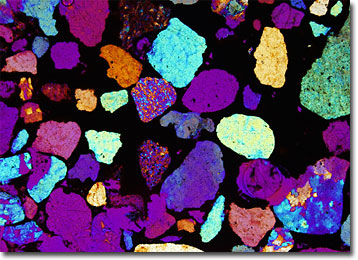Polarized Light Microscopy Digital Image Gallery
Quartz Conglomerate
Quartz is a common mineral that appears in wide variety of forms and colors. Though chiefly comprised of silica or silicon dioxide, various other substances, such as sodium, lithium, or titanium, may be found in quartz in small quantities.

Quartz conglomerate is a lithified sedimentary rock that is primarily composed of rounded pebbles of quartz. These pebbles are generally greater than two millimeters in diameter and are cemented together in such away that the rock appears quite similar to concrete, with which it is often confused by casual observers. One of the largest quartz conglomerate deposits in the world can be found in Olean, New York.
A type of quartz conglomerate that contains variously colored pebbles is frequently referred to as puddingstone. The pebbles in this rock are often jasper, a type of opaque quartz that may be brown, red, or yellow, but may also consist of various other minerals. The assortment of colored pebbles in the ground matrix is generally believed to resemble raisins, nuts, and other fruits in a pudding, hence the name of the rock. Extremely hard, puddingstones can be polished to a nice luster and are often utilized as ornamental rocks, sometimes appearing in cut form as bookends, fountains, necklaces, and similar items.
